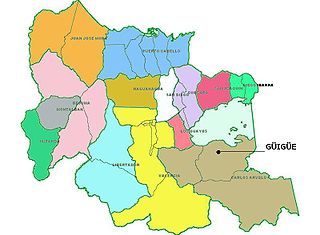Related Research Articles

Municipalities of Venezuela are subdivisions of the States of Venezuela. There are 335 municipalities dividing the 23 states and the Capital District.

The Central University of Venezuela is a public university located in Caracas, Venezuela. Founded in 1721, it is the oldest university in Venezuela and one of the oldest in the Western Hemisphere.

The National Pantheon of Venezuela is a final resting place for national heroes. The Pantheon was created in the 1870s on the site of the ruined Santísima Trinidad church from 1744 on the northern edge of the old town of Caracas, Venezuela.

José António Marques was the founder of the Portuguese Red Cross.

Guigue is a city in the south of the Valencia Lake, in Carabobo, Venezuela. It is the capital of the Carlos Arvelo Municipality and of the Guigue parish. The Guigue River flows through the city, draining in Lake Valencia.
Enrique Cornelio Osornio Martínez de los Ríos was a Mexican politician and military surgeon with the rank General Brigadier Médico Cirujano.
Fernando Ocaranza Carmona was a Mexican surgeon, rector of the Universidad Nacional Autónoma de México (UNAM), and military in the rank of a Coronel (MC).

Science and technology in Venezuela includes research based on exploring Venezuela's diverse ecology and the lives of its indigenous peoples.
Francisco José Herrera Luque was a Venezuelan writer, psychiatrist and diplomat. He is the author of several well-known historical novels, including: Boves, el Urogallo (1972), Los Amos del Valle (1979) and La Luna de Fausto (1983).

Luis Razetti was a surgeon, who supported and managed a number of advances in the progress of Venezuelan medicine. He gained his Doctorate in Medicine from the Central University of Venezuela, is considered the driving-force in the "Renaissance of the Venezuelan medicine", concerning education, research centers and medical practices in Venezuela. One of the two schools of Medicine of the Central University of Venezuela bears his name. Together with Dr. José María Vargas and Dr. José Gregorio Hernández, Dr. Luis Razetti stands out among the most valuable figures in Venezuelan medicine. His remains rest in the National Pantheon of Venezuela in Caracas since June 23, 1982.
Miguel Pérez Carreño (1904–1966) was a Venezuelan physician, researcher, scientist, university professor and writer. He was born in Valencia, Carabobo (Venezuela) on September 28, 1904 and died in Caracas on June 22, 1966). He was the son of Venezuelan Government physician, doctor and lawyer Luis Pérez-Carreño and Doña Encarnación Espinal. He was part of a distinguished family, consisting of figures such as Simón Rodríguez and Teresa Carreño. He taught several generations of surgeons. The hospital belonging to the Venezuelan Institute of Social Security, located in El Pescozón to the west of Caracas, bears his name.

Conductores de Venezuela is a giant ceramic mural on a wall outside the Covered Gymnasium at the Central University of Venezuela, facing out to the Francisco Fajardo freeway. It was designed by cartoonist Pedro León Zapata and installed over a period of years in the late 1990s; it depicts cartoon Venezuelan people driving, with several vehicles having important Venezuelans from history behind the wheel.

Francisco Narváez was commissioned to create pieces for the University City of Caracas campus in 1949, initially working between 1950 and 1953, with other pieces added later. The artworks include stone and metal statues, busts, reliefs, and various material of murals. Three of the statues are made of Cumarebo stone: El Atleta, a large statue in the sports complex, and La educación and La ciencia in the medical complex. The Cumarebo stone is a favourite material of Narváez. Two sculptures of the esteemed doctor José Gregorio Hernández and President José María Vargas grace the campus grounds.

Alirio Rodríguez was a Venezuelan painter and visual artist. He was born in El Callao, Venezuela, and died in Caracas, Venezuela. His art was widely acclaimed in his native Venezuela and abroad, winning him multiple awards and recognitions as one of the top Venezuelan plastic artists of the 20th century.

Samuel Darío Maldonado Vivas was a Venezuelan surgeon, anthropologist, writer, journalist and politician. He is known for his work as a sanitary doctor and as director of the National Health Office during the government of Juan Vicente Gómez.
Pablo Acosta Ortiz Revete (1864–1914) was a Venezuelan medical doctor, academic, surgeon, politician and college professor known as the magician of the scalpel and considered the founder of modern surgery in Venezuela. He attended the 4th and 5th Pan American Sanitary Conferences as a representative of Venezuela.
The Pablo Acosta Ortiz square or Altagraciasquare is a public space located in the city of Barquisimeto in the center west of Venezuela, more specifically in the state of Lara. One of the best known and most emblematic space of the city. It bears the name and bust over a marble pedestal of the highest exponent of Venezuelan medicine the famous doctor, Pablo Acosta Ortiz. The square is located in front of the Altagracia church.
The Tazón Massacre occurred on September 19, 1984 in the toll of Tazón, Caracas, Venezuela, when officials of the National Guard fired on more than 200 students from the Maracay campus of the Central University of Venezuela who had arrived in four buses to a protest, causing a toll of at least 35 injured. Despite the name "massacre", no student died during the protest. The incident generated multiple student protests in various universities across the country against the behaviour of the security personnel and the demand for the resignation of the university chancellor, Edmundo Chirinos.
References
- 1 2 "Doctor Carlos Arvelo Guevara, eminente médico, valeroso capitán".
- ↑ Kinnell, Susan (1989). People in World History, Volume 1. ISBN 9780874365511.
- 1 2 3 4 "Médico, militar y docente (1784-1862)" (PDF).
- 1 2 3 "Entre Hipocrates y Marte: Dr. Carlos Arvelo Guevara".
- 1 2 3 "Doctor Carlos Arvelo Guevara".
- 1 2 3 4 Cordero-Moreno, Rafael (1998). Compendio de la historia de la medicina en Venezuela. ISBN 9789802441631.